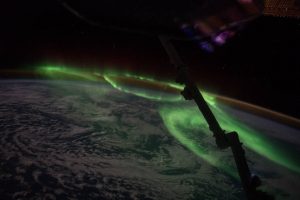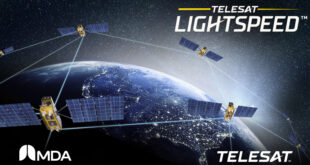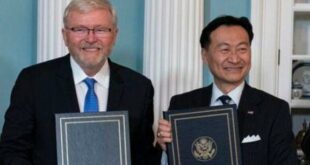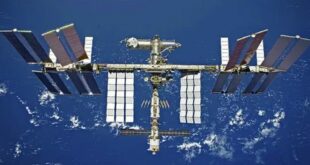
By Dr. Malcolm Davis
There’s been great interest about the establishment of a “United States Space Force” by the Trump Administration. President Trump began promoting the concept of a sixth and fully independent military force for space since early 2018, and the actual space force was formalised under a Congressional spending bill on December 20, 2019.
This development raises new opportunities for Australia to push forward its own space capabilities to pursue tighter cooperation and integration with US and other five-eyes partners in Space. We need to burden share in orbit to a greater degree than we’ve done in the past.
The idea of a space force has promoted both informed policy debate and a good deal of amusement over more trivial matters, such as what uniforms the new force might wear, what’s the logo, and is Trump’s thinking driven by notions from pop culture – think Star Wars or Star Trek.
It’s important to clear the nonsense away from this issue to focus on more significant matters.
The US Space Force is a logical outcome of the need to ensure continued access to space. Australia recognises that space is vital to our military, and more broadly, our prosperity and the efficient functioning of our society. So, we need to observe US developments closely and seek to embrace opportunities for closer collaboration with the US and other partners in space.
Most Australian military capabilities wouldn’t function without access to space. For example, the same GPS satellites that make our mobile phones so useful, also provide essential positioning, navigation and timing functions that are crucial for modern military command and control, for precision navigation on the battlefield and also for accurate guidance of weapons. The Australian Defence Force relies heavily on satellite communications to facilitate long-range operations, such as in Iraq and Afghanistan. Without access to US surveillance satellites the ADF couldn’t plan or carry out operational missions or deliver accurate mapping services. And the military, just like everyone else, relies on weather satellites to understand the operating environment for deployed forces whether fighting a war, or undertaking disaster relief in the recent bushfire crisis.
Put simply, without space capability, the ADF would be deaf, dumb and blind, unable to coordinate and control its operations, or understand the operational environment. The end result would be far higher potential risk of casualties, and ultimately defeat in war. It would be a weaker, less effective military.
With this reality in mind, its important to note that the US Space Force is a response to Chinese and Russian anti-satellite weapons developments. Both states are developing anti-satellite (ASAT) weapons designed to attack, disrupt, and disable US and allied satellites prior to, or at the outset of the next military conflict. In 2007 China used an ASAT to destroy one of its own inactive satellites in low-earth orbit, creating clouds of space debris. China and Russia are also developing ‘soft kill’ technologies that don’t physically destroy, but instead disable a target satellite, thus avoiding creating space debris. The soft kill capabilities can proliferate quickly, with one example, cyber warfare against satellites or space-related ground facilities, a new challenge we will face in coming years.
Without space capability, the ADF would be deaf, dumb and blind, unable to coordinate and control its operations, or understand the operational environment.
Australia needs to take seriously developing the means to ensure continued access to space in the face of these challenges. Australia is well positioned to play a key role alongside the US and other five eyes partners including the UK, Canada, and New Zealand, to meet this challenge.
Australia’s space industry sector can directly support Defence’s space requirements in coming years, through local development of small satellites for defence purposes, and to build the capability to launch those Australian satellites on Australian launch vehicles from Australian launch sites.
Rather than depend on a small number of complex and expensive US satellites to support the ADF, the objective should be to build a degree of space sovereignty for Australia for the future.
Locally developed satellites can augment US space capabilities to provide additional space capability to both the US military and the ADF.
In the face of adversary counterspace threats, it’s important to disaggregate allied space capabilities across larger numbers of small, low-cost satellites to make essential space services more survivable. Developing a sovereign responsive launch capability dramatically opens up an ability to rapidly deploy these small satellites and reconstitute lost capability in wartime whilst boosting the economic returns from Australia’s space industry sector in peacetime. The combination of these benefits is a greater ability to burden share in orbit with the US space force along with developing a vibrant and rapidly growing commercial space sector.
Secondly, Australia should seize the potential offered by the US space force development to inform Australia’s defence policy future thinking on how to organise, train and sustain for space. Ideally, we need to reorganise Defence in a manner that recognises that space is an operational domain in its own right, just like air, sea, land and cyber. Its not merely an enabling adjunct.
Does that mean Australia needs its own Space Force? Certainly, the ADF needs a “space command” within the RAAF in which space operations, doctrine and capability development are managed by a cadre of space professionals. Defence also needs an unclassified space strategy that informs those functions in an accountable way. These would be good steps to formally embrace in the next defence white paper.
Thirdly, Defence needs to explore ways to more closely integrate with the US and other five eyes partners – and Japan, as well as France – on space activities for national security. Australia has signed up to the 2014 Combined Space Operations (CSpO) Initiative between the five eyes partners and is a participant in the Schriever space war exercises in the US. Australia’s role in these activities should be expanded. Maybe it’s time for a “CSpO Plus” dialogue process, that expands staff exchanges, allows greater participation in joint exercises, and opens up common capability development.
For Australia, the establishment of the US Space Force should be seen as an opportunity to take the next steps forward as a new and importance space power in the 2020s and beyond.

Dr. Malcolm Davis is a senior analyst in defence strategy and capability and a space policy expert with the Australian Strategic Policy Institute in Canberra, Australia.
This Op-Ed is republished here with the kind permission of The Canberra Times, and the original was first published on 29 January 2020 and can be found here.





